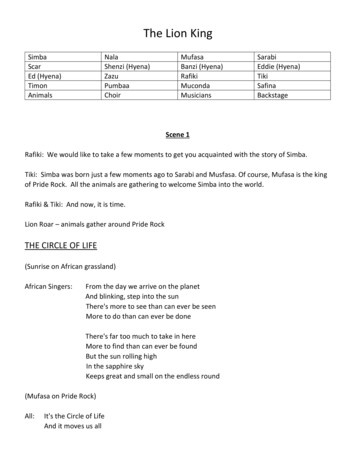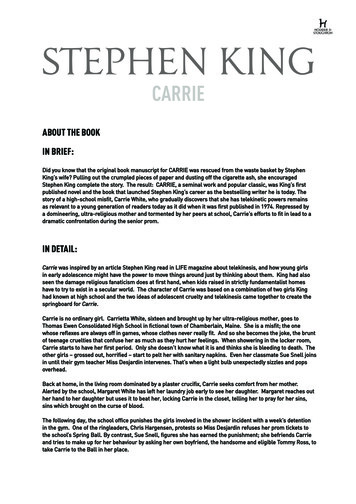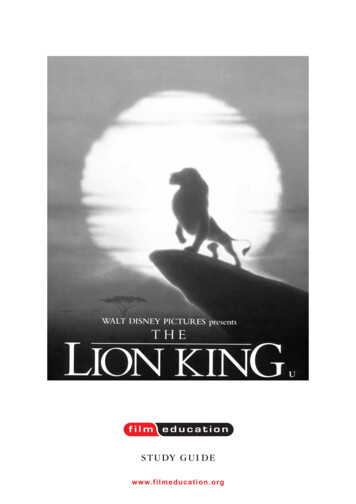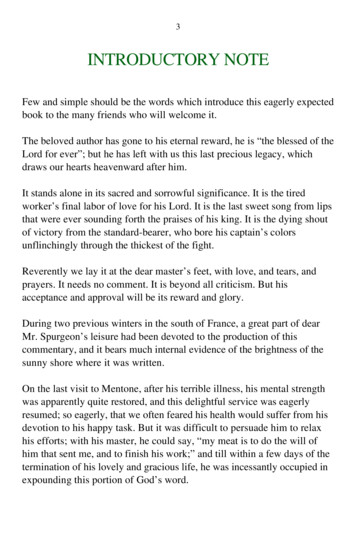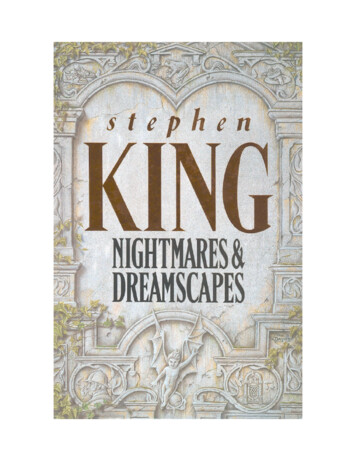
Transcription
By Stephen King and published byNew English LibraryCarrie'Salem's LotThe ShiningNight ShiftThe StandBy Stephen King as Richard BachmanThinnerThe Bachman BooksPublished by Hodder & StoughtonChristinePet SemataryItMiseryThe TommyknockersThe Dark HalfThe Stand: the Complete and Uncut EditionFour Past MidnightNeedful ThingsGerald's GameDolores Claiborne
PUBLISHER'S NOTEMost of the selections in this book are works of fiction. Names,characters, places and incidents either are the product of the author'simagination or are used fictitiously, and any resemblance to actualpersons, living or dead, events, or locales is entirely coincidental.British Library Cataloguing in Publication DataA CIP catalogue record for this title is available fromthe British LibraryISBN 0-340-59282-6Copyright 1993 by Stephen KingFirst published in Great Britain 1993All rights reserved. No part of this publication may be reproduced or transmitted in any form or byany means, electronic or mechanical, including photocopying, recording, or any informationstorage and retrieval system, without either prior permission in writing from the publisher or alicence permitting restricted copying. In the United Kingdom such licences are issued by theCopyright Licensing Agency, 90 Tottenham Court Road, London W1P 9HE. The right of StephenKing to be identified as the author of this work has been asserted by him in accordance with theCopyright, Designs and Patents Act 1988.Published by Hodder and Stoughton,a division of Hodder and Stoughton Ltd,Mill Road, Dunton Green, Sevenoaks, Kent TN13 2YA.Editorial Office: 47 Bedford Square, London WC1B 3DPPhotoset by Rowland Phototypesetting Ltd,Bury St Edmunds, SuffolkPrinted in Great Britain byMackays of Chatham plc, Chatham, Kent
In memory of Thomas Williams, 1926-1991: poet, novelist,And great American storyteller.
Illustration from The Mysteries of Harris Burdick by Chris Van Allsburg 1984 by Chris VanAllsburg, reprinted by permission of Houghton Mifflin Company. All rights reserved.The following selections, some in different form, were previously published: 'Dolan's Cadillac'in the Castle Rock Newsletter; 'The End of the Whole Mess' in Omni; 'Suffer the Little Children'and 'The Fifth Quarter' in Cavalier; 'The Night Flier' in Prime Evil: New Stories by the Masters ofModern Horror edited by Douglas E. Winter, New American Library; 'Popsy' in Masques II: All-NewStories of Horror and the Supernatural edited by J. N. Williamson, Maclay Associates; 'It Grows onYou' in Marshroots; 'Chattery Teeth' in Cemetery Dance Magazine; 'Dedication' and 'Sneakers' inNight Visions V by Stephen King, et al., Dark Harvest; 'The Moving Finger' in Science Fiction andFantasy; 'You Know They Got a Hell of a Band' in Shock Rock edited by Jeff Gelb and Claire Zion,Pocket Books; 'Home Delivery' in Book of the Dead, Mark Ziesing, publisher; 'Rainy Season' inMidnight Graffiti edited by Jessica Horsting and James Van Hise, Warner Books; 'Crouch End' inNew Tales of the Cthulhu Mythos by H. P. Lovecraft, et al., Arkham House; 'The Doctor's Case' in NewAdventures of Sherlock Holmes by Stephen King, et al., edited by Martin Greenberg and Carol-LynnRossel Waugh, Carroll & Graf; 'Head Down' in The New Yorker; 'Brooklyn August' in Io.'Dolan's Cadillac' was later published in a limited edition by Lord John Press. 'My Pretty Pony'was published in a limited edition by the Whitney Museum of Art.
ContentsIntroductionDolan's CadillacThe End of the Whole MessSuffer the Little ChildrenThe Night FlierPopsyIt Grows on YouChattery TeethDedicationThe Moving FingerSneakersYou Know They Got a Hell of a BandHome DeliveryRainy SeasonMy Pretty PonySorry, Right NumberThe Ten O' Clock PeopleCrouch EndThe House on Maple StreetThe Fifth QuarterThe Doctor's CaseUmney's Last CaseHead DownBrooklyn AugustNotes
Introduction:Myth, Belief, Faith and Ripley'sBelieve It or Not!When I was a kid I believed everything I was told, everything I read, and every dispatch sent out bymy own overheated imagination. This made for more than a few sleepless nights, but it also filled theworld I lived in with colors and textures I would not have traded for a lifetime of restful nights. Iknew even then, you see, that there were people in the world — too many of them, actually — whoseimaginative senses were either numb or completely deadened, and who lived in a mental state akin tocolorblindness. I always felt sorry for them, never dreaming (at least then) that many of these unimaginative types either pitied me or held me in contempt, not just because I suffered from anynumber of irrational fears but because I was deeply and unreservedly credulous on almost everysubject. 'There's a boy,' some of them must have thought (I know my mother did), 'who will buy theBrooklyn Bridge not just once but over and over again, all his life.'There was some truth to that then, I suppose, and if I am to be honest, I suppose there's sometruth to it now. My wife still delights in telling people that her husband cast his first Presidentialballot, at the tender age of twenty-one, for Richard Nixon. 'Nixon said he had a plan to get us out ofVietnam,' she says, usually with a gleeful gleam in her eye, 'and Steve believed him!'That's right; Steve believed him. Nor is that all Steve has believed during the often-eccentric courseof his forty-five years. I was, for example, the last kid in my neighborhood to decide that all thosestreet-corner Santas meant there was no real Santa (I still find no logical merit in the idea; it's like sayingthat a million disciples prove there is no master). I never questioned my Uncle Oren's assertion thatyou could tear off a person's shadow with a steel tent-peg (if you struck precisely at high noon, thatwas) or his wife's claim that every time you shivered, a goose was walking over the place where yourgrave would someday be. Given the course of my life, that must mean I'm slated to end up buriedbehind Aunt Rhody's barn out in Goose Wallow, Wyoming.I also believed everything I was told in the schoolyard; little minnows and whale-sized whopperswent down my throat with equal ease. One kid told me with complete certainty that if you put a dimedown on a railroad track, the first train to come along would be derailed by it. Another kid told methat a dime left on a railroad track would be perfectly smooshed (that was exactly how he put it —perfectly smooshed) by the next train, and what you took off the rail after the train had passed wouldbe a flexible and nearly transparent coin the size of a silver dollar. My own belief was that boththings were true: that dimes left on railroad tracks were perfectly smooshed before they derailed thetrains which did the smooshing.Other fascinating schoolyard facts which I absorbed during my years at Center School in Stratford,Connecticut, and Durham Elementary School in Durham, Maine, concerned such diverse subjects asgolf-balls (poisonous and corrosive at the center), miscarriages (sometimes born alive, as malformedmonsters which had to be killed by health-care individuals ominously referred to as 'the special nurses'),black cats (if one crossed your path, you had to fork the sign of the evil eye at it quickly or risk
almost certain death before the end of the day), and sidewalk cracks. I probably don't have to explainthe potentially dangerous relationship of these latter to the spinal columns of completely innocentmothers.My primary sources of wonderful and amazing facts in those days were the paperback compilationsfrom Ripley's Believe It or Not! which were issued by Pocket Books. It was in Ripley's that Idiscovered you could make a powerful explosive by scraping the celluloid off the backs of playingcards and then tamping the stuff into a length of pipe, that you could drill a hole in your own skulland then plug it with a candle, thereby turning yourself into a kind of human night-light (why anyonewould want to do such a thing was a question which never occurred to me until years later), that therewere actual giants (one man well over eight feel tall), actual elves (one woman barely eleven inches tall),and actual MONSTERS TOO HORRIBLE TO DESCRIBE . . . except Ripley's described them all, in lovingdetail, and usually with a picture (if I live to be a hundred, I'll never forget the one of the guy withthe candle stuck in the center of his shaved skull).That series of paperbacks was — to me, at least — the world's most wonderful sideshow, one I couldcarry around in my back pocket and curl up with on rainy weekend afternoons, when there were nobaseball games and everyone was tired of Monopoly. Were all of Ripley's fabulous curiosities andhuman monsters real? In this context that hardly seems relevant. They were real to me, and thatprobably is — during the years from six to eleven, crucial years in which the human imagination islargely formed, they were very real to me. I believed them just as I believed you could derail afreight-train with a dime or that the drippy goop in the center of a golf-ball would eat the hand rightoff your arm if you were careless and got some of it on you. It was in Ripley's Believe It or Not!that I first began to see how fine the line between the fabulous and the humdrum could sometimesbe, and to understand that the juxtaposition of the two did as much to illuminate the ordinaryaspects of life as it did to illuminate its occasional weird outbreaks. Remember it's belief we'retalking about here, and belief is the cradle of myth. What about reality, you ask? Well, as far asI'm concerned, reality can go take a flying fuck at a rolling doughnut. I've never held much of abrief for reality, at least in my written work. All too often it is to the imagination what ash stakesare to vampires.I think that myth and imagination are, in fact, nearly interchangeable concepts, and that beliefis the wellspring of both. Belief in what? I don't think it matters very much, to tell you the truth.One god or many. Or that a dime can derail a freight-train.These beliefs of mine had nothing to do with faith; let's be very clear on that subject. I wasraised Methodist and hold onto enough of the fundamentalist teachings of my childhood to believethat such a claim would be presumptuous at best and downright blasphemous at worst. I believedall that weird stuff because I was built to believe in weird stuff. Other people run races becausethey were built to run fast, or play basketball because God made them six-foot-ten, or solve long,complicated equations on blackboards because they were built to see the places where the numbersall lock together.Yet faith comes into it someplace, and I think that place has to do with going back to do thesame thing again and again even though you believe in your deepest, truest heart that you willnever be able to do it any better than you already have, and that if you press on, there's really noplace to go but downhill. You don't have anything to lose when you take your first whack at thepiñata, but to take a second one (and a third . . . and a fourth . . . and a thirty-fourth) is to riskfailure, depression, and, in the case of the short-story writer who works in a pretty well definedgenre, self-parody. But we do go on, most of us, and that gets to be hard. I never would havebelieved that twenty years ago, or even ten, but it does. It gets hard. And I have days when I
think this old Wang word-processor stopped running on electricity about five years ago; that fromThe Dark Half on, it's been running completely on faith. But that's okay; whatever gets the wordsacross the screen, right?The idea of each of the stories in this book came in a moment of belief and was written in aburst of faith, happiness, and optimism. Those positive feelings have their dark analogues,however, and the fear of failure is a long way from the worst of them. The worst — for me, atleast — is the gnawing speculation that I may have already said everything I have to say, and amnow only listening to the steady quacking of my own voice because the silence when it stops is justtoo spooky.The leap of faith necessary to make the short stories happen has gotten particularly tough inthe last few years; these days it seems that everything wants to be a novel, and every novel wantsto be approximately four thousand pages long. A fair number of critics have mentioned this, andusually not favorably. In reviews of every long novel I have written, from The Stand to NeedfulThings, I have been accused of overwriting. In some cases the criticisms have merit; in others theyare just the ill-tempered yappings of men and women who have accepted the literary anorexia ofthe last thirty years with a puzzling (to me, at least) lack of discussion and dissent. These selfappointed deacons in the Church of Latter-Day American Literature seem to regard generositywith suspicion, texture with dislike, and any broad literary stroke with outright hate. The resultis a strange and arid literary climate where a meaningless little fingernail-paring like NicholsonBaker's Vox becomes an object of fascinated debate and dissection, and a truly ambitiousAmerican novel like Greg Matthews's Heart of the Country is all but ignored.But all that is by the by, not only off the subject but just a tiny bit whimpery, too — after all,was there ever a writer who didn't feel that he or she had been badly treated by the critics? All Istarted to say before I so rudely interrupted myself was that the act of faith which turns a momentof belief into a real object — i.e., a short story that people will actually want to read — has beena little harder for me to come by in the last few years.'Well then, don't write them,' someone might say (only it's usually a voice I hear inside my ownhead, like the ones Jessie Burlingame hears in Gerald's Game}. 'After all, you don't need the moneythey bring in the way you once did.'That's true enough. The days when a check for some four-thousand-word wonder would buypenicillin for one of the kids' ear infections or help meet the rent are long gone. But the logic ismore than spurious; it's dangerous. I don't exactly need the money the novels bring in, either, yousee. If it was just the money, I could hang up my jock and hit the showers . . . or spend the restof my life on some Caribbean island, catching the rays and seeing how long I could grow myfingernails.But it isn't about the money, no matter what the glossy tabloids may say, and it's not aboutselling out, as the more arrogant critics really seem to believe. The fundamental things stillapply as time goes by, and for me the object hasn't changed — the job is still getting to you,Constant Reader, getting you by the short hairs and, hopefully, scaring you so badly you won't beable to go to sleep without leaving the bathroom light on. It's still about first seeing theimpossible . . . and then saying it. It's still about making you believe what I believe, at least for alittle while.I don't talk about this much, because it embarrasses me and it sounds pompous, but I still seestories as a great thing, something which not only enhances lives but actually saves them. Nor am Ispeaking metaphorically. Good writing — good stories — are the imagination's firing pin, and thepurpose of the imagination, I believe, is to offer us solace and shelter from situations and life-passages
which would otherwise prove unendurable. I can only speak from my own experience, of course, but forme, the imagination which so often kept me awake and in terror as a child has seen me throughsome terrible bouts of stark raving reality as an adult. If the stories which have resulted from thatimagination have done the same for some of the people who've read them, then I am perfectly happyand perfectly satisfied — feelings which cannot, so far as I know, be purchased with rich moviedeals or multi-million-dollar book contracts.Still, the short story is a difficult and challenging literary form, and that's why I was so delighted— and so surprised — to find I had enough of them to issue a third collection. It has come at apropitious time, as well, because one of those facts of which I was so sure as a kid (I probably pickedit up in Ripley's Believe It or Not!, too) was that people completely renew themselves every sevenyears: every tissue, every organ, every muscle replaced by entirely new cells. I am drawing Nightmaresand Dreamscapes together in the summer of 1992, seven years after the publication of Skeleton Crew,my last collection of short stories, and Skeleton Crew was published seven years after Night Shift, myfirst collection. The greatest thing is knowing that, although the leap of faith necessary to translate anidea into reality has become harder (the jumping muscles get a little older every day, you know), it's stillperfectly possible. The next greatest thing is knowing that someone still wants to read them —that's you, Constant Reader, should you wonder.The oldest of these stories (my versions of the killer golf-ball goop and monster miscarriages, ifyou will) is 'It Grows on You', originally published in a University of Maine literary magazine calledMarshroots . . . although it has been considerably revised for this book, so it could better be what itapparently wanted to be — a final look back at the doomed little town of Castle Rock. The mostrecent, 'The Ten O'Clock People', was written in three fevered days during the summer of 1992.There are some genuine curiosities here — the first version of my only original teleplay; a SherlockHolmes story in which Dr Watson steps forward to solve the case; a Cthulhu Mythos story set in thesuburb of London where Peter Straub lived when I first met him; a hardboiled 'caper' story of theRichard Bachman stripe; and a slightly different version of a story called 'My Pretty Pony', whichwas originally done as a limited edition from the Whitney Museum, with artwork by Barbara Kruger.After a great deal of thought, I've also decided to include a lengthy non-fiction piece, 'HeadDown', which concerns kids and baseball. It was originally published in The New Yorker, and Iprobably worked harder on it than anything else I've written over the last fifteen years. That doesn'tmake it good, of course, but I know that writing and publishing it gave me enormous satisfaction,and I'm passing it along for that reason. It doesn't really fit in a collection of stories which concernthemselves mostly with suspense and the supernatural . . . except somehow it does. The texture isthe same. See if you don't think so.What I've tried hardest to do is to steer clear of the old chestnuts, the trunk stories, and thebottom-of-the-drawer stuff. Since 1980 or so, some critics have been saying I could publish mylaundry list and sell a million copies or so, but these are for the most part critics who think that'swhat I've been doing all along. The people who read my work for pleasure obviously feel differently,and I have made this book with those readers, not the critics, in the forefront of my mind. The result, Ithink, is an uneven Aladdin's cave of a book, one which completes a trilogy of which Night Shift andSkeleton Crew are the first two volumes. All the good short stories have now been collected; all the badones have been swept as far under the rug as I could get them, and there they will stay. If there is tobe another collection, it will consist entirely of stories which have not as yet been written or evenconsidered (stories which have not yet been believed, if you will), and I'd guess it will show up in ayear which begins with a 2.
Meantime, there are these twenty-odd (and some, I should warn you, are very odd). Each containssomething I believed for awhile, and I know that some of these things — the finger poking out ofthe drain, the man-eating toads, the hungry teeth — are a little frightening, but I think we'll be allright if we go together. First, repeat the catechism after me:I believe a dime can derail a freight-train.I believe there are alligators in the New York City sewer system, not to mention rats as big asShetland ponies.I believe that you can tear off someone's shadow with a steel tent-peg.I believe that there really is a Santa Claus, and that all those red-suited guys you see atChristmastime really are his helpers.I believe there is an unseen world all around us.I believe that tennis balls are full of poison gas, and if you cut one in two and breathe what comesout, it'll kill you.Most of all, I do believe in spooks, I do believe in spooks, I do believe in spooks.Okay? Ready? Fine. Here's my hand. We're going now. I know the way. All you have to do is holdon tight . . . and believe.Bangor, MaineNovember 6, 1992
Waking? Sleeping?Which side of the line are thedreams really on?
Dolan's CadillacRevenge is a dish best eaten cold.Spanish proverbI waited and watched for seven years. I saw him come and go — Dolan. I watched him stroll intofancy restaurants dressed in a tuxedo, always with a different woman on his arm, always with hispair of bodyguards bookending him. I watched his hair go from iron-gray to a fashionable silverwhile my own simply receded until I was bald. I watched him leave Las Vegas on his regularpilgrimages to the West Coast; I watched him return. On two or three occasions I watched from aside road as his Sedan DeVille, the same color as his hair, swept by on Route 71 toward LosAngeles. And on a few occasions I watched him leave his place in the Hollywood Hills in thesame gray Cadillac to return to Las Vegas — not often, though. I am a schoolteacher.Schoolteachers and high-priced hoodlums do not have the same freedom of movement; it's justan economic fact of life.He did not know I was watching him — I never came close enough for him to know that. Iwas careful.He killed my wife or had her killed; it comes to the same, either way. Do you want details?You won't get them from me. If you want them, look them up in the back issues of the papers.Her name was Elizabeth. She taught in the same school where I taught and where I teach still.She taught first-graders. They loved her, and I think that some of them may not have forgottentheir love still, although they would be teenagers now. I loved her and love her still, certainly.She was not beautiful but she was pretty. She was quiet, but she could laugh. I dream of her. Ofher hazel eyes. There has never been another woman for me. Nor ever will be.He slipped — Dolan. That's all you have to know. And Elizabeth was there, at the wrong placeand the wrong time, to see the slip. She went to the police, and the police sent her to the FBI, andshe was questioned, and she said yes, she would testify. They promised to protect her, but theyeither slipped or they underestimated Dolan. Maybe it was both. Whatever it was, she got intoher car one night and the dynamite wired to the ignition made me a widower. He made me awidower — Dolan.With no witness to testify, he was let free.He went back to his world , I to mine. The penthouse apartment in Vegas for him, the emptytract home for me. The succession of beautiful women in furs and sequined evening dresses forhim, the silence for me. The gray Cadillacs, four of them over the years, for him, and the agingBuick Riviera for me. His hair went silver while mine just went.But I watched.I was careful — oh, yes! Very careful. I knew what he was, what he could do. I knew hewould step on me like a bug if he saw or sensed what I meant for him. So I was careful.
During my summer vacation three years ago I followed him (at a prudent distance) to LosAngeles, where he went frequently. He stayed in his fine house and threw parties (I watched thecomings and goings from a safe shadow at the end of the block, fading back when the police carsmade their frequent patrols), and I stayed in a cheap hotel where people played their radios tooloud and neon light from the topless bar across the street shone in the windows. I fell asleep onthose nights and dreamed of Elizabeth's hazel eyes, dreamed that none of it had ever happened,and woke up sometimes with tears drying on my face.I came close to losing hope.He was well guarded, you see; so well guarded. He went nowhere without those two heavilyarmed gorillas with him, and the Cadillac itself was armor plated. The big radial tires it rolled onwere of the self-sealing type favored by dictators in small, uneasy countries.Then, that last time, I saw how it could be done — but I did not see it until after I'd had a verybad scare.I followed him back to Las Vegas, always keeping at least a mile between us, sometimes two,sometimes three. As we crossed the desert heading east his car was at times no more than asunflash on the horizon and I thought about Elizabeth, how the sun looked on her hair.I was far behind on this occasion. It was the middle of the week, and traffic on US 71 was verylight. When traffic is light, tailing becomes dangerous — even a grammar-school teacher knowsthat. I passed an orange sign which read DETOUR 5 MILES and dropped back even farther.Desert detours slow traffic to a crawl, and I didn't want to chance coming up behind the grayCadillac as the driver babied it over some rutted secondary road.DETOUR 3 MILES, the next sign read, and below that: BLASTING AREA AHEAD TURNOFF 2-WAY RADIO.I began to muse on some movie I had seen years before. In this film a band of armed robbershad tricked an armored car into the desert by putting up false detour signs. Once the driver fellfor the trick and turned off onto a deserted dirt road (there are thousands of them in the desert,sheep roads and ranch roads and old government roads that go nowhere), the thieves hadremoved the signs, assuring isolation, and then had simply laid siege to the armored car until theguards came out.They killed the guards.I remembered that.They killed the guards.I reached the detour and turned onto it. The road was as bad as I had imagined packed dirt,two lanes wide, filled with potholes that made my old Buick jounce and groan. The Buickneeded new shock absorbers, but shocks are an expense a schoolteacher sometimes has to putoff, even when he is a widower with no children and no hobbies except his dream of revenge.As the Buick bounced and wallowed along, an idea occurred to me. Instead of followingDolan's Cadillac the next time it left Vegas for LA or LA for Vegas, I would pass it — get aheadof it. I would create a false detour like the one in the movie, luring it out into the wastes thatexist, silent and rimmed by mountains, west of Las Vegas. Then I would remove the signs, as thethieves had done in the movie —I snapped back to reality suddenly. Dolan's Cadillac was ahead of me, directly ahead of me,pulled off to one side of the dusty track. One of the tires, self-sealing or not, was flat. No — notjust flat. It was exploded, half off the rim. The culprit had probably been a sharp wedge of rockstuck in the hardpan like a miniature tank-trap. One of the two bodyguards was working a jack
under the front end. The second — an ogre with a pig-face streaming sweat under his brush cut— stood protectively beside Dolan himself. Even in the desert, you see, they took no chances.Dolan stood to one side, slim in an open-throated shirt and dark slacks, his silver hair blowingaround his head in the desert breeze. He was smoking a cigarette and watching the men as if hewere somewhere else, a restaurant or a ballroom or a drawing room perhaps.His eyes met mine through the windshield of my car and then slid off with no recognition atall, although he had seen me once, seven years ago (when I had hair!), at a preliminary hearing,sitting beside my wife.My terror at having caught up with the Cadillac was replaced with an utter fury.I thought of leaning over and unrolling the passenger window and shrieking: How dare youforget me? How dare you dismiss me? Oh, but that would have been the act of a lunatic. It wasgood that he had forgotten me, it was fine that he had dismissed me, better to be a mouse behindthe wainscoting, nibbling at the wires. Better to be a spider, high up under the eaves, spinning itsweb.The man sweating the jack flagged me, but Dolan wasn't the only one capable of dismissal. Ilooked indifferently beyond the arm-waver, wishing him a heart attack or a stroke or, best of all,both at the same time. I drove on — but my head pulsed and throbbed, and for a few momentsthe mountains on the horizon seemed to double and even treble.If I'd had a gun! I thought. If only Id had a gun! I could have ended his rotten, miserable liferight then if I'd only had a gun!Miles later some sort of reason reasserted itself If I'd had a gun, the only thing I could havebeen sure of was getting myself killed. If I'd had a gun I could have pulled over when the manusing the bumper-jack beckoned me, and gotten out, and begun spraying bullets wildly aroundthe deserted landscape. I might have wounded someone. Then I would have been killed andburied in a shallow grave, and Dolan would have gone on escorting the beautiful women andmaking pilgrimages between Las Vegas and Los Angeles in his silver Cadillac while the desertanimals unearthed my remains and fought over my bones under the cold moon. For Elizabeththere would have been no revenge — none at all.The men who travelled with him were trained to kill. I was trained to teach third-graders.This was not a movie, I reminded myself as I returned to the highway and passed an orangeEND CONSTRUCTIONTHE STATE OF NEVADA THANKS YOU! sign. And if I evermade the mistake of confusing reality with a movie, of thinking that a balding third-grade teacherwith myopia could ever be Dirty Harry anywhere outside of his own daydreams, there wouldnever be any revenge, ever.But could there be revenge, ever? Could there be?My idea of creating a fake detour was as romantic and unrealistic as the idea of jumping out ofmy old Buick and spraying the three of them with bullets — me, who had not fired a gun sincet
Adventures of Sherlock Holmes by Stephen King, et al., edited by Martin Greenberg and Carol-Lynn Rossel Waugh, Carroll & Graf; 'Head Down' in The New Yorker; 'Brooklyn August' in Io. 'Dolan's Cadillac' was later published in a limited edition by Lord John Press. 'My Pretty Pony' was pub
